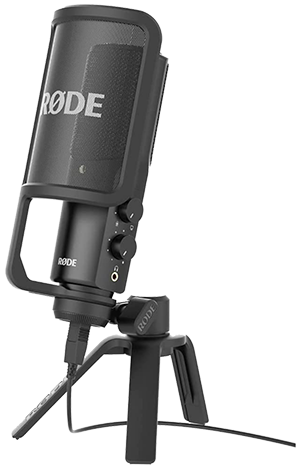How to Record Podcasts
It seems so easy and obvious. If you want to record a podcast, you get a mic, hook it up to your computer and start recording. Right?
Well, yes but….
There are many thousands of people doing that. And yet only a few of those podcasts sound really good. Really professional. So what makes the difference?
Start With a Good Microphone
You don’t need a super high-end mic. But you also don’t want a super cheap one. There are so many different kinds of microphones to choose from, but let me help you narrow that down.
For recording voices, you are going to want (with very few exceptions) a microphone with a large “diaphragm” – the membrane inside the grill that captures the sound.
USB Microphone
If you are on a budget, I recommend the RODE NT-USB+ microphone. This is the best sounding USB mic I’ve tested. USB mics are less expensive and easier to use than standard microphones. They plug directly into a USB port on your computer.

But just having a good mic does not guarantee a good recording! People make bad recordings with great mics every day. You need to know how to use the mic properly. And you also need to reduce noise and room reverb in the space where you record.
I recorded a video to accompany the review I did of the RODE NT-USB+. That will give you some good tips on how to use that mic. Check that out here: My Review of The RØDE NT-USB+ Microphone (video).
Standard Microphone
Standard mics are the kind with the 3-pin connector (XLR). And they require an additional piece of equipment called an audio recording interface. You can get more detailed info interfaces in my post: What Is An Audio Recording Interface? But basically, it is a small box (usually) that you plug your mic into. And the interface then plugs into a USB port on your computer. There are tons to choose from. But I use and recommend a Focusrite Scarlett.

Again, we are looking for a large-diaphragm mic. For vocals, condenser microphones are the most common kind. There are tons of these out there. But one I can recommend for both quality and price is the Audio-Technica AT2035. My review of that mic – along with audio samples so you can hear what it sounds like – is here: Review of the Audio-Technica AT2035 Microphone (Audio Samples).

There is another kind of large-diaphragm standard mic that is very popular with podcasters. You’ve probably seen them on TV or YouTube. It is a “dynamic” mic. Unlike condenser mics, dynamics don’t require phantom power (though you still need an interface; you just won’t turn the “phantom power” button on). And because they are less sensitive, especially to higher frequencies, they tend to record less background noise than condenser mics.
And mics like the Shure SM7b (as well as the other super popular large dynamic mic, the Electro-Voice RE20) have been used by broadcasters in radio stations for decades. They have a good track record of being great for recording conversational voices.

How to use microphones to capture the best sound
Like I mentioned earlier, it’s easy and common to still record bad audio even with a great mic. So how do you record the best sound?
Well, there are several things you can do, especially when recording at home in a converted bedroom or home office. And I go into many of them in my post series here: Improve The Quality Of The Audio You Record At Home. But if I were limited to one single thing, it would be this. Get your mouth close to the mic! I mean like 3-4 inches away. This might seem a little close, but there is no faster way to limit room reverb (the bane of audio recorded in home studios) than this. See the video in the link above, where you can hear how dramatic a difference this makes.
You can get more tips in the “Improve The Quality…” post series linked above.
Podcasting Interfaces and Mixers
There are some other issues that come up with recording a podcast with other people – co-hosts and guests, etc. One of the common issues comes up when your guest is calling in on a phone. Recording yourself AND someone on the phone can lead to echos and delays from the phone and your voice and their voice. It can be a mess. But this problem is prevented with some of the most common interfaces made specifically for recording podcasts.
My favorite of these is the Zoom Podtrack P4. I reviewed that interface and the post for it (with audio samples) is here: My Review of The Zoom PodTrak P4 Podcasting Interface. I also listed several interfaces for podcasting here: Audio Interface Or Mixer For Podcasting.
So these tips should get you started on your way to recording professional sounding podcasts. After everything is recorded, you’ll need to edit it to polish it up and get it ready to share with the world. You can find all the information you need to record, edit and produce podcasts (as well as audiobooks and voiceovers) in my new course, Professional Talkers: How To Record High Quality Audio For VoiceOvers, Podcasts & More.
Let me know in the comments below if you have any questions.
